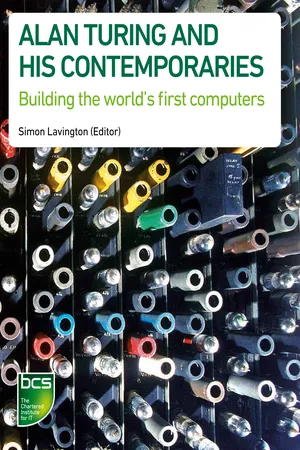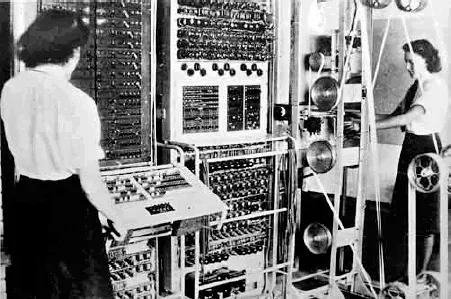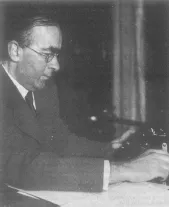
- 130 pages
- English
- ePUB (mobile friendly)
- Available on iOS & Android
eBook - ePub
About this book
Secret wartime projects in code-breaking, radar and ballistics produced a wealth of ideas and technologies that kick-started the development of digital computers. This is the story of the people and projects that flourished in the post-war period. By 1955 computers had begun to appear in the market-place. The Information Age was dawning and Alan Turing and his contemporaries held centre stage. Their influence is still discernable deep down within today's hardware and software.
Frequently asked questions
Yes, you can cancel anytime from the Subscription tab in your account settings on the Perlego website. Your subscription will stay active until the end of your current billing period. Learn how to cancel your subscription.
No, books cannot be downloaded as external files, such as PDFs, for use outside of Perlego. However, you can download books within the Perlego app for offline reading on mobile or tablet. Learn more here.
Perlego offers two plans: Essential and Complete
- Essential is ideal for learners and professionals who enjoy exploring a wide range of subjects. Access the Essential Library with 800,000+ trusted titles and best-sellers across business, personal growth, and the humanities. Includes unlimited reading time and Standard Read Aloud voice.
- Complete: Perfect for advanced learners and researchers needing full, unrestricted access. Unlock 1.4M+ books across hundreds of subjects, including academic and specialized titles. The Complete Plan also includes advanced features like Premium Read Aloud and Research Assistant.
We are an online textbook subscription service, where you can get access to an entire online library for less than the price of a single book per month. With over 1 million books across 1000+ topics, we’ve got you covered! Learn more here.
Look out for the read-aloud symbol on your next book to see if you can listen to it. The read-aloud tool reads text aloud for you, highlighting the text as it is being read. You can pause it, speed it up and slow it down. Learn more here.
Yes! You can use the Perlego app on both iOS or Android devices to read anytime, anywhere — even offline. Perfect for commutes or when you’re on the go.
Please note we cannot support devices running on iOS 13 and Android 7 or earlier. Learn more about using the app.
Please note we cannot support devices running on iOS 13 and Android 7 or earlier. Learn more about using the app.
Yes, you can access Alan Turing and his Contemporaries by Simon Lavington in PDF and/or ePUB format, as well as other popular books in Computer Science & Computer Science General. We have over one million books available in our catalogue for you to explore.
Information
1
THE IDEAS MEN
Simon Lavington
SCIENCE AT WAR
The momentous events of the Second World War saw countless acts of bravery and sacrifice on the part of those caught up in the conflict. Rather less perilously, large numbers of mathematicians, scientists and engineers found themselves drafted to government research establishments where they worked on secret projects that also contributed to the Allied war effort. This book is about the people who took the ideas and challenges of wartime research and applied them to the new and exciting field of electronic digital computer design. It is a complex story, since the modern computer did not spring from the efforts of one single inventor or one single laboratory. In this chapter we give an overall sense of the people involved and the places in Britain and America where, by 1945, ideas for new forms of computing were beginning to emerge.
In Britain the secret wartime establishment that is now the most famous was the Government Code and Cipher School at Bletchley Park in Buckinghamshire. Bletchley Park together with its present-day successor organisation, the Government Communications Headquarters (GCHQ), may be well known now but in the 1940s – and indeed right up to the 1970s – very few people were aware of the code-breaking activity that had gone on there during the war. The mathematician Alan Turing was perhaps the most brilliant of the team of very clever people recruited to work there. In the spirit of the time, let us keep the story of Bletchley Park hidden for the moment. We shall return to it after introducing examples of other scientific work that went on in Britain and America during the war.
In both countries research into radar featured prominently. The challenge was to improve the accuracy and range of detection of targets, for which vacuum tube (formerly called ‘thermionic valve’) technology and electronic pulse techniques were stretched to the limit. The Telecommunications Research Establishment (TRE) at Malvern, Worcestershire, became a world-class centre for electronics excellence, especially as applied to airborne radar. Research for ship-borne naval radar was carried out at the Admiralty Signals Establishment (ASE) at Haslemere and Witley in Surrey.
See Sidebar Bletchley Park and Colossus

To analyse and decipher the Lorenz messages, mathematicians at Bletchley Park and engineers from the Post Office’s Research Station at Dollis Hill developed the Colossus series of high-speed electronic digital machines. Operational from December 1943, these Colossus machines were of crucial importance to the Allied war effort. However, their design had little impact upon early general-purpose computers for two reasons: firstly, their very existence was not made public until the 1970s; secondly, they were special-purpose machines with very little internal storage.
You can visit Bletchley Park today and see working replicas of a Bombe and a Colossus.

Professor Douglas Hartree is shown here in about 1935 operating a Brunsviga mechanical desk calculating machine. Hartree (1897–1958) was a mathematical physicist who specialised in numerical computation and organised computing resources during the Second World War. After the war he took the lead in encouraging the design and use of the new prototype universal stored-program computers for science and engineering.
In 1945, as hostilities ended, senior people from the various British and American research establishments visited each other’s organisations and exchanged ideas. Amongst the subjects often discussed was the task of carrying out the many kinds of calculations and simulations necessary for weapons development and the production of military hardware. During the war scientific calculations had been done on a range of digital and analogue machines, both large and small. The great majority of these calculators were mechanical or electromechanical. In Britain the mathematician and physicist Douglas Hartree had masterminded many of the more important wartime computations required by government research establishments. In America one particular research group had decided to overcome the shortcomings of the slow electromechanical calculators by introducing high-speed electronic techniques. It was thus that in 1945, in Pennsylvania, the age of electronic digital computing was dawning.
THE MOORE SCHOOL: THE CRADLE OF ELECTRONIC COMPUTING
A huge electronic calculator called ENIAC (Electronic Numerical Integrator and Computer) was developed under a US government contract at the Moore School of Electrical Engineering at the University of Pennsylvania. The spur for ENIAC had been the need to speed up the process of preparing ballistic firing tables for artillery. Leading the development team were two academics: the electrical engineer Presper Eckert and the physicist John Mauchley. As the work of building the huge machine progressed a renowned mathematician from Princeton University, John von Neumann, was also drawn into the project. Von Neumann subsequently (in about 1948) used ENIAC for calculations associated with the development of the hydrogen bomb.
See Sidebar ENIAC
Even before ENIAC itself had been completed the team working on it was producing ideas for a successor computer, to be called EDVAC, the Electronic Discrete Variable Automatic Computer. The team’s ideas addressed a challenge: how to make ENIAC more general purpose, so that its benefits could be more easily applied to a much wider range of computational tasks. The ideas were written up by John von Neumann in June 1945 in a 101-page document entitled First draft of a report on the EDVAC. By 1946 copies of this report were being distributed widely and were read with interest on both sides of the Atlantic. A project to build EDVAC was launched in 1946, but due to organisational problems the machine did not become operational until 1951.
Most importantly, however, the EDVAC Report of 1945 contained the first widely available account of what we would now recognise as a general-purpose stored-program electronic digital computer. EDVAC has become formally known as a ‘stored-program’ computer because a single memory was used to store both the program instructions and the numbers on which the program operated. The stored-program concept is the basis of almost all computers today. Machines that conform to the EDVAC pattern are also sometimes called ‘von Neumann’ computers, to acknowledge the influence of the report’s author.
The June 1945 EDVAC document was in fact a paper study, more or less complete in principle but lacking engineering detail. Once hostilities in the Pacific had ceased there was an understandable desire to consolidate the Moore School’s wartime ideas and to explain the details to a wider American audience. Accordingly, the US government funded an eight-week course of lectures in July–August 1946 on the ‘Theory and Techniques for Design of Electronic Digital Computers’. Twenty-eight scientists and engineers were invited to attend. Amongst these were just three Englishmen: David Rees, Maurice Wilkes and Douglas Hartree. David Rees had worked at Bletchley Park and then, when the war ended, had joined the Mathematics Department at Manchester University. Maurice Wilkes had worked at TRE during the war and had returned to Cambridge University to resume his leading role at the Mathematical Laboratory (later to become the Computer Laboratory). Douglas Hartree, at that time Professor of Physics at Manchester University but soon to move to Cambridge, was invited to give a lecture on ‘Solution of problems in applied mathematics’.
The EDVAC Report and the Moore School lectures were the inspiration for several groups worldwide to consider designing their own general-purpose electronic computers. Certainly Maurice Wilkes’s pioneering computer design activity at Cambridge University, described in Chapter 3, grew out of the Moore School ideas. The Moore School’s activities were also of considerable interest to Rees’s Head of Department at Manchester University, Professor Max Newman, who had been at Bletchley Park during the war. What happened at Manchester after 1946 is explained in Chapter 4.

Professor Max Newman (1897– 1984) was a Cambridge mathematician who joined Bletchley Park in 1942 to work on cryptanalysis. He specified the logical design of the Colossus code-cracking machine. In 1945 Newman moved to Manchester University, where he encouraged the start of a computer design project and promoted its use for investigating logical problems in mathematics.
Although the ideas promoted by the Moore School were of equal interest to Alan Turing, they were to produce a different kind of effect upon his thinking.
THE UNIVERSAL TURING MACHINE
Alan Turing was a most remarkable man. A great original, quite unmoved by authority, convention or bureaucracy, he turned his fertile mind to many subjects during his tragically short life. Though classed in the Scientific Hall of Fame as a mathematician and logician, he explored areas as diverse as artificial intelligence (AI) and morphogenesis (the growth and form of living things).
See Sidebar Alan Turing
Why was the young Alan Turing, just back from completing a doctorate in America, one of the first mathematicians to be recruited to help with code-cracking at Bletchley Park in 1939? The answer probably lies in a theoretical paper that he had written back in 1935–6, whilst a postgraduate at King’s College, Cambridge.
Turing’s paper was called ‘On Computable Numbers, with an application to the Entscheidungsproblem’. In plain English, it was Turing’s attempt to tackle one of the important philosophical and logical problems of the time: Is mathematics decidable? This question had been posed by scholars who were interested in finding out what could, and what could not, be proved by a given mathematical theory. In order to reason about this so-called Entscheidungsproblem, Turing had the idea of using a conceptual automatic calculating device. The ‘device’ was a step-by-step process – more a thought-experiment, really – that manipulated symbols according to a small list of very basic instructions. The working storage and the input–output medium for the process was imagined to be an infinitely long paper tape that could be moved backwards and forwards past a sensing device.
It is now tempting to see Turing’s mechanical process as a simple description of a modern computer. Whilst that is partly true, Turing’s Universal Machine was much more than this: it was a logical tool for proving the decidability, or undecidability, of mathematical problems. As such, Turing’s Universal Machine continues to be used as a conceptual reference by theoretical computer scientists to this day. Certainly it embodies the idea of a stored program, making it clear that instructions are just a type of data and can be stored and manipulated in the same way. (If all this seems confusing, don’t worry! It is not crucial to an understanding of the rest of this book.)
In the light of his theoretical work and his interest in ciphers, Alan Turing was sent to Bletchley Park on 4 September 1939. He was immediately put to work cracking the German Naval Enigma codes. He succeeded. It has been said that as Bletchley Park grew in size and importance Turing’s great contribution was to encourage the other code-breakers in the teams to think in terms of probabilities and the quantification of weight of evidence. Because of this and other insights, Turing quickly became the person to whom all the other Bletchley Park mathematicians turned when they encountered a particularly tricky decryption problem.
On the strength of his earlier theoretical work Alan Turing was recruited by the National Physical Laboratory (NPL) at Teddington in October 1945, as described in Chapter 2. Senior staff at NPL had heard about ENIAC and EDVAC and wished to build a general-purpose digital computer of their own. Turing, they felt, was the man for the job. It is very likely that at NPL Turing saw an opportunity to devise a physical embodiment of the theoretical principles first described in his ‘On Computable Numbers’ paper. Although he was well aware of the developments at the Moore School and knew John von Neumann personally, Turing was not usually inclined to follow anyone else’s plans. Within three months he had sketched out the complete design for his own general-purpose stored-program computer – which, however, did adopt the notation and terminology used in the EDVAC Report. For reasons described in Chapter 2, Turing’s paper design for what was called ACE, the Automatic Computing Engine, remained a paper design for some years.
PRACTICAL PROBLEMS, 1945–7
To some extent the problems that beset Turing at NPL also dogged other pioneering computer design groups in the immediate post-war years. The main problem was computer storage. Central to the idea of ...
Table of contents
- FRONT COVER
- HALFTITLE PAGE
- BCS THE CHARTERED INSTITUTE FOR IT
- TITLE
- COPYRIGHT PAGE
- CONTENTS
- AUTHORS
- ACKNOWLEDGEMENTS
- PREFACE
- 1 THE IDEAS MEN
- 2 ACES AND DEUCES
- 3 IVORY TOWERS AND TEA ROOMS
- 4 THE MANCHESTER MACHINES
- 5 MEANWHILE, IN DEEPEST HERTFORDSHIRE
- 6 ONE MAN IN A BARN
- 7 INTO THE MARKETPLACE
- 8 HINDSIGHT AND FORESIGHT: THE LEGACY OF TURING AND HIS CONTEMPORARIES
- APPENDIX A: TECHNICAL COMPARISON OF FIVE EARLY BRITISH COMPUTERS
- APPENDIX B: TURING AND COMPUTING: A TIMELINE
- APPENDIX C: FURTHER READING
- BACK COVER